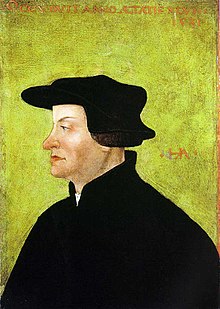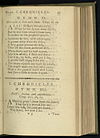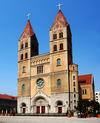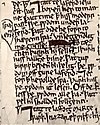January 2010
The Ten Commandments are a series of religious and moral imperatives that are recognized as a moral foundation in Judaism, Christianity and Islam. The Commandments are described in the Old Testament books of Exodus and Deuteronomy, where they are said to form part of a covenant offered by God to the Israelites. According to the Catechism of the Catholic Church—the official exposition of the Catholic Church's Christian beliefs—the Commandments are considered essential for spiritual good health and growth, and serve as the basis for Catholic social teaching. A review of the Commandments is one of the most common types of examination of conscience used by Catholics before receiving the sacrament of Penance.
The Commandments appear in the earliest Church writings; the Catechism states that they have "occupied a predominant place" in teaching the faith since the time of Saint Augustine (AD 354–430). The Church had no official standards for religious instruction until the Fourth Lateran Council in 1215; evidence suggests the Commandments were used in Christian education in the Early Church and throughout the Middle Ages, but with inconsistent emphasis. The lack of instruction in them by some dioceses formed the basis of one of the criticisms launched against the Church by Protestant reformers. Afterward, the first Church-wide catechism in 1566 provided "thorough discussions of each commandment", but gave greater emphasis to the seven sacraments. The most recent Catechism devotes a large section to interpret each of the commandments.
(more)February 2010
Church teaching of the Commandments is largely based on the Old and New Testaments and the writings of the early Church Fathers. In the New Testament, Jesus acknowledged their validity and instructed his disciples to go further, demanding a righteousness exceeding that of the scribes and Pharisees. Summarized by Jesus into two "great commandments" that teach love of God and love of neighbor, they instruct individuals on their relationships with both. The first three commandments demand respect for God's name, observation of the Lord's Day and prohibit the worship of other gods. The others deal with the relationships between individuals, such as that between parent and child; they include prohibitions against lying, stealing, murdering, adultery and covetousness.
(more)March 2010
Ecclesiastical heraldry is the tradition of heraldry developed by Christian clergy. Initially used to mark documents, ecclesiastical heraldry evolved as a system for identifying people and dioceses. It is most formalized within the Roman Catholic Church, where most bishops, including the Pope, have a personal coat of arms. Similar customs are followed by clergy in the Anglican Church, the Lutheran Church, the Eastern Rite Catholic Churches, and the Eastern Orthodox Churches. Institutions such as schools and dioceses bear arms called impersonal or corporate arms. Ecclesiastical heraldry differs notably from other heraldry in the use of special symbols around the shield to indicate rank in a church or denomination. The most prominent of these symbols is the ecclesiastical hat, commonly the Roman galero or Geneva bonnet. The color and ornamentation of this hat carry a precise meaning. Cardinals are famous for the "red hat", but other offices are assigned a distinctive hat color. The hat is ornamented with tassels in a quantity commensurate with the office. Other symbols include the cross, the mitre and the crozier.
(more)April 2010

Jesus of Nazareth (c. 5 BC/BCE – c. 30 AD/CE),[1] also known as Jesus Christ or Jesus, is the central figure of Christianity, which views him as the Messiah foretold in the Old Testament, with most Christian denominations believing him to be the Son of God and God incarnate who was raised from the dead.[2] Islam considers Jesus a prophet and also the Messiah.[3] Several other religions revere him in some way. He is one of the most influential figures in human history.
The principal sources of information regarding Jesus' life and teachings are the four canonical gospels, especially the Synoptic Gospels,[4][5] though some scholars argue such texts as the Gospel of Thomas and the Gospel of the Hebrews [6][7] are also relevant.[8]
Most critical scholars in biblical studies believe that some parts of the New Testament are useful for reconstructing Jesus' life,[9][10][11][12] agreeing that Jesus was a Jew who was regarded as a teacher and healer, that he was baptized by John the Baptist, and was crucified in Jerusalem on the orders of the Roman Prefect of Judaea, Pontius Pilate, on the charge of sedition against the Roman Empire.[13][14][15][16][17][18][19][20][21][22][23][24] Aside from these few conclusions, academic debate continues regarding the chronology, the central message of Jesus' preaching, his social class, cultural environment, and religious orientation.[8] Critical scholars have offered competing descriptions of Jesus as a self-described Messiah, as the leader of an apocalyptic movement, as an itinerant sage, as a charismatic healer, and as the founder of an independent religious movement. Most contemporary scholars of the historical Jesus consider him to have been an independent, charismatic founder of a Jewish restoration movement, anticipating an imminent apocalypse.[25] Other prominent scholars, however, contend that Jesus' "Kingdom of God" meant radical personal and social transformation instead of a future apocalypse.[25]
Christians predominantly believe that Jesus is the "Son of God" (generally meaning that he is God the Son, the second person in the Trinity) who came to provide salvation and reconciliation with God by his death for their sins.[26]: 568–603 Christians traditionally believe that Jesus was born of a virgin,[26]: 529–532 performed miracles,[26]: 358–359 founded the Church, rose from the dead, and ascended into Heaven,[26]: 616–620 from which he will return.[26]: 1091–1109 While the doctrine of the Trinity is accepted by most Christians, a few groups reject the doctrine of the Trinity, wholly or partly, as non-scriptural.[27] Most Christian scholars today present Jesus as the awaited Messiah[28] and as God.
In Islam, Jesus (Arabic: عيسى, commonly transliterated as Isa) is considered one of God's important prophets,[29][30] a bringer of scripture, and a worker of miracles. Jesus is also called "Messiah", but Islam does not teach that he was divine. Islam teaches that Jesus ascended bodily to heaven without experiencing the crucifixion and resurrection,[31] rather than the traditional Christian belief of the death and resurrection of Jesus.May 2010
June 2010
July 2010

Huldrych (or Ulrich[32]) Zwingli (1 January 1484 – 11 October 1531) was a leader of the Reformation in Switzerland. Born during a time of emerging Swiss patriotism and increasing criticism of the Swiss mercenary system, he attended the University of Vienna and the University of Basel, a scholarly centre of humanism. He continued his studies while he served as a pastor in Glarus and later in Einsiedeln where he was influenced by the writings of Erasmus.
In 1519, Zwingli became the pastor of the Grossmünster in Zürich where he began to preach ideas on reforming the Catholic Church. In his first public controversy in 1522, he attacked the custom of fasting during Lent. In his publications, he noted corruption in the ecclesiastical hierarchy, promoted clerical marriage, and attacked the use of images in places of worship. In 1525, Zwingli introduced a new communion liturgy to replace the mass. Zwingli also clashed with the Anabaptists, which resulted in their persecution.
The Reformation spread to other parts of the Swiss Confederation, but several cantons resisted, preferring to remain Catholic. Zwingli formed an alliance of Reformed cantons which divided the Confederation along religious lines. In 1529, a war between the two sides was averted at the last moment. Meanwhile, Zwingli’s ideas came to the attention of Martin Luther and other reformers. They met at the Marburg Colloquy and although they agreed on many points of doctrine, they could not reach an accord on the doctrine of the presence of Christ in the eucharist. In 1531 Zwingli’s alliance applied an unsuccessful food blockade on the Catholic cantons. The cantons responded with an attack at a moment when Zürich was badly prepared. Zwingli was killed in battle at the age of 47. His legacy lives on in the confessions, liturgy, and church orders of the Reformed churches of today.August 2010

"Amazing Grace" is a Christian hymn written by English poet and clergyman John Newton (1725–1807), published in 1779. With a message that forgiveness and redemption are possible regardless of the sins people commit and that the soul can be delivered from despair through the mercy of God, "Amazing Grace" is one of the most recognizable songs in the English-speaking world. Newton wrote the words from personal experience. He grew up without any particular religious conviction but his life's path was formed by a variety of twists and coincidences that were often put into motion by his recalcitrant insubordination. He was pressed into the Royal Navy and became a sailor, eventually participating in the slave trade. One night a terrible storm battered his vessel so severely that he became frightened enough to call out to God for mercy, a moment that marked the beginning of his spiritual conversion.
Author Gilbert Chase writes that "Amazing Grace" is "without a doubt the most famous of all the folk hymns", and Jonathan Aitken, a Newton biographer, estimates that it is performed about 10 million times annually. It has had particular influence in folk music, and become an emblematic African American spiritual. Its universal message has been a significant factor in its crossover into secular music. "Amazing Grace" saw a resurgence in popularity in the U.S. during the 1960s and has been recorded thousands of times during and since the 20th century, sometimes appearing on popular music charts.
(more)September 2010

"Amazing Grace" is a Christian hymn written by English poet and clergyman John Newton (1725–1807), published in 1779. With a message that forgiveness and redemption are possible regardless of the sins people commit and that the soul can be delivered from despair through the mercy of God, "Amazing Grace" is one of the most recognizable songs in the English-speaking world. Newton wrote the words from personal experience. He grew up without any particular religious conviction but his life's path was formed by a variety of twists and coincidences that were often put into motion by his recalcitrant insubordination. He was pressed into the Royal Navy and became a sailor, eventually participating in the slave trade. One night a terrible storm battered his vessel so severely that he became frightened enough to call out to God for mercy, a moment that marked the beginning of his spiritual conversion.
Author Gilbert Chase writes that "Amazing Grace" is "without a doubt the most famous of all the folk hymns", and Jonathan Aitken, a Newton biographer, estimates that it is performed about 10 million times annually. It has had particular influence in folk music, and become an emblematic African American spiritual. Its universal message has been a significant factor in its crossover into secular music. "Amazing Grace" saw a resurgence in popularity in the U.S. during the 1960s and has been recorded thousands of times during and since the 20th century, sometimes appearing on popular music charts.
(more)October 2010
St. Michael's Cathedral is a Catholic church in Qingdao (formerly Tsingtao), Shandong Province, People's Republic of China; it is also the seat of the Bishop of the Roman Catholic Diocese of Qingdao. It is located in the oldest part of Qingdao, in Shinan District. It is the largest example of Romanesque Revival architecture in the province. St. Michael's Cathedral is the product of a strong German presence in Shandong Province in the 19th and early 20th centuries. In the mid-19th century the European powers forcibly opened China to foreign trade. The Divine Word Missionaries built a church in the Jiaozhou Bay concession in Shandong in 1902, and in 1934 erected the cathedral, which remained nominally under their administration until 1964. In 1942 it came under the control of the Japanese Army, returning to Chinese control when the Japanese left Qingdao in 1945. In the early 1950s, all foreign missionaries, including the Bishop of Qingdao, were either imprisoned or expelled from China, and during the Cultural Revolution (1966–1976) the cathedral was defaced and abandoned. In 1981, it was repaired and reopened for services, and in 1992 it was listed as a Provincial Historic Building by the government.
(more)November 2010
The Ormulum is a 12th-century work of biblical exegesis, written in early Middle English verse by a monk named Orm (or Ormin). Because of the unique phonetic orthography adopted by the author, it preserves many details of English pronunciation at a time when the language was in flux after the Norman Conquest. Consequently, and in spite of its lack of literary merit, it is invaluable to philologists in tracing the development of the language. Orm was concerned with priests' ability to speak the vernacular, and developed an idiosyncratic spelling system to guide his readers to pronounce each vowel. He composed using a strict poetic meter which ensured that readers would know which syllables were stressed. Modern scholars use these two features to reconstruct Middle English as Orm spoke it.
(more)December 2010
- ^ Sanders (1993).p.11, p 249.
- ^ Theologian and bishop Lesslie Newbigin says "the whole of Christian teaching would fall to the ground if it were the case that the life, death, and resurrection of Jesus were not events in real history but stories told to illustrate truths which are valid apart from these happenings." Newbigin, J. E. L. (1989). "The Gospel In a Pluralist Society". London: SPCK. p. 66.
- ^ Abdulsalam, M. (19 February 2008). "Jesus in Islam". IslamReligion.com.
- ^ "The Gospel of John is quite different from the other three gospels, and it is primarily in the latter that we must seek information about Jesus." Sanders (1993), p. 57.
- ^ Funk, Robert W.; Seminar, Jesus (1998). "Introduction". The acts of Jesus: the search for the authentic deeds of Jesus. San Francisco: Harper San Francisco. pp. 1–40. ISBN 978-0-06-062978-6.
- ^ P. Parker, A Proto-Lukan Basis for the Gospel According to the Hebrews Journal of Biblical Literature, Vol. 59, No. 4 (Dec., 1940), pp. 471-473
- ^ J. R. Edwards, The Hebrew Gospel & the Development of the Synoptic Tradition, Eerdmans Publishing, 2009 pp. 1-376
- ^ a b Levine, Amy-Jill (1998). "Visions of Kingdoms: From Pompey to the First Jewish Revolt (63 BCE—70 CE)". In Coogan, Michael D. (ed.). The Oxford History of the Biblical World. New York and Oxford: Oxford University Press. pp. 370–371. ISBN 978-0-19-508707-9.
- ^ Funk, Robert W.; Hoover, Roy W.; Jesus Seminar (1993). "Introduction". The Five Gospels. New York: Maxwell Macmillan. pp. 1–30. ISBN 978-0-02-541949-0.
- ^ Harris, Stephen L. (1985). Understanding the Bible : a reader's introduction. Palo Alto: Mayfield. pp. 255–260. ISBN 978-0-87484-696-6.
- ^ Crossan, John Dominic (1998). The essential Jesus : original sayings and earliest images. Edison, NJ: Castle Books. ISBN 978-0-7858-0901-2.
- ^ Examples of authors who argue the Jesus myth hypothesis:
- Thompson, Thomas L. (2006). The messiah myth: The near eastern roots of Jesus and David. London: Jonathan Cape. ISBN 978-0-224-06200-8.
- Martin, Michael (1991). The case against Christianity. Philadelphia: Temple University Press. pp. 36–72. ISBN 978-1-56639-081-1.
- Robertson, John Mackinnon
- ^ Brown, Raymond E. (1994). The death of the Messiah : from Gethsemane to the grave : a commentary on the Passion narratives in the four Gospels. New York: Doubleday, Anchor Bible Reference Library: Doubleday. p. 964. ISBN 978-0-385-19397-9.
- ^ Carson, D. A.; et al. pp. 50–56.
{{cite book}}: Missing or empty|title=(help) - ^ Cohen (1987). pp. 78, 93, 105, 108.
{{cite book}}: Missing or empty|title=(help) - ^ Crossan. The Historical Jesus. pp. xi–xiii.
- ^ Grant, Michael. pp. 34–35, 78, 166, 200.
{{cite book}}: Missing or empty|title=(help) - ^ Paula Fredriksen (1999). Jesus of Nazareth, King of the Jews. Alfred A. Knopf. pp. 6–7, 105–110, 232–234, 266.
- ^ Meier, John P. (1993). Vol. 1:68, 146, 199, 278, 386, 2:726. Sanders. pp. 12–13.
{{cite book}}: Missing or empty|title=(help) - ^ Vermes, Géza (1973). Jesus the Jew. Philadelphia: Fortress Press. p. 37.
- ^ Maier, Paul L. (1991). In the Fullness of Time. Kregel. pp. 1, 99, 121, 171.
- ^ Wright, N. T. (1998). The Meaning of Jesus: Two Visions. HarperCollins. pp. 32, 83, 100–102, 222.
- ^ Witherington, Ben III. pp. 12–20.
{{cite book}}: Missing or empty|title=(help) - ^ Though many historians may have certain reservations about the use of the Gospels for writing history, "even the most hesitant, however, will concede that we are probably on safe historical footing" concerning certain basic facts about the life of Jesus; Cruz, Jo Ann H. Moran; Gerberding, Richard (2004). Medieval Worlds: An Introduction to European History. Houghton Mifflin Company. pp. 44–45.
- ^ a b Theissen, Gerd and Annette Merz. The historical Jesus: a comprehensive guide. Fortress Press. 1998. translated from German (1996 edition). Chapter 1. Quest of the historical Jesus. p. 1-16
- ^ a b c d e Grudem, Wayne (1994). Systematic Theology: An Introduction to Biblical Doctrine. Grand Rapids: Zondervan. ISBN 0-310-28670-0.
- ^ Friedmann, Robert (1953). "Antitrinitarianism". Global Anabaptist Mennonite Encyclopedia Online. Retrieved June 8, 2008.
- ^ For instance Brown, Raymond E. (1979). The Birth of the Messiah. Garden City, NY: Image Books. p. 9. ISBN 978-0-385-05405-8.
- ^ Houlden, James L. (2005). Jesus: The Complete Guide. London: Continuum. ISBN 978-0-8264-8011-8.
- ^ Prof. Dr. Şaban Ali Düzgün (2004). "Uncovering Islam: Questions and Answers about Islamic Beliefs and Teachings". Ankara: The Presidency of Religious Affairs Publishing.
- ^ "Compendium of Muslim Texts".
- ^ Potter 1976, p. 1. According to Potter, "Huldrych" was the spelling Zwingli preferred. However, Potter uses "Ulrich", while Gäbler, Stephens, and Furcha use "Huldrych". His signature at the Marburg Colloquy was the Latinised name "Huldrychus Zwinglius" (Bainton 1995, p. 251). For more on his name, see Rother, Rea. "Huldrych - Ulrich". Evangelisch-reformierte Landeskirche des Kantons Zürich. Retrieved 2008-03-03. (in German only, Reformed Church of Zürich)




